Evaluation of high-speed laser triangulation and LIDAR for turbulent water surface ranging
IF 2.8
2区 工程技术
Q2 ENGINEERING, MECHANICAL
Experimental Thermal and Fluid Science
Pub Date : 2025-02-11
DOI:10.1016/j.expthermflusci.2025.111432
引用次数: 0
Abstract
This study presents a comparison of high-speed laser triangulation and laser scanning, two advanced measurement methods for capturing the free water surface of complex hydraulic phenomena characterized by turbulent, non-stationary, and non-homogeneous flows. The methods were applied to measure the turbulent, aerated water surface of a flow under supercritical flow conditions, defined by high Reynolds and Froude numbers. Measurements were conducted using a high-speed camera operating on the principle of laser triangulation, and a laser scanner serving as a light source. Data evaluation was performed for three cross-sections along the confluence, indicating a very good overall agreement between both measuring systems with mean discrepancies of 0.26 mm horizontally and 2.7 mm vertically, which fall within the reported systematic and statistical errors of the light detection and ranging (LIDAR) device. With most relative errors within ±10 %, the mean differences between the two measurement systems were an order of magnitude smaller than the temporal and spatial fluctuations of the observed free surfaces, and the instantaneous errors remained within the physical range of these fluctuations. Further error analysis revealed that high-speed triangulation underestimates free surface levels in flows with steadier, well-defined water surfaces, and overestimates in regions with highly transient and poorly defined surfaces compared to LIDAR. These discrepancies were attributed to differing system sensitivities. The high-speed camera sensor exhibits higher sensitivity, capturing more reflections from water droplets and successive reflections from submerged air bubbles compared to the LIDAR device. This highlights the need for further investigation into these error sources and the development of more robust data filtering techniques. Overall, both methods effectively captured the complex dynamics of turbulent aerated flows, showing promising capabilities for measuring turbulent water surfaces in laboratory environments.
高速激光三角测量和激光雷达对湍流水面测距的评价
本文对高速激光三角测量和激光扫描这两种先进的测量方法进行了比较,以捕获湍流、非平稳和非均匀流动为特征的复杂水力现象的自由水面。这些方法用于测量由高雷诺数和弗劳德数定义的超临界流动条件下的湍流加气水面。测量是使用高速相机操作的原理激光三角测量和激光扫描仪作为光源。对汇合处的三个横截面进行了数据评估,表明两种测量系统之间的总体一致性非常好,平均水平差为0.26 mm,垂直差为2.7 mm,这属于光探测和测距(LIDAR)装置的系统和统计误差。两种测量系统的平均误差在±10%以内,比观测自由表面的时空波动小一个数量级,瞬时误差保持在这些波动的物理范围内。进一步的误差分析表明,与激光雷达相比,高速三角测量法低估了具有更稳定、清晰水面的流动中的自由表面水平,而高估了具有高度瞬态和模糊表面的区域。这些差异归因于不同的系统敏感性。与激光雷达设备相比,高速相机传感器具有更高的灵敏度,可以捕获更多来自水滴的反射和来自水下气泡的连续反射。这突出了进一步研究这些误差源和开发更健壮的数据过滤技术的必要性。总的来说,这两种方法都有效地捕获了湍流加气流动的复杂动力学,显示出在实验室环境中测量湍流水面的良好能力。
本文章由计算机程序翻译,如有差异,请以英文原文为准。
求助全文
约1分钟内获得全文
求助全文
来源期刊

Experimental Thermal and Fluid Science
工程技术-工程:机械
CiteScore
6.70
自引率
3.10%
发文量
159
审稿时长
34 days
期刊介绍:
Experimental Thermal and Fluid Science provides a forum for research emphasizing experimental work that enhances fundamental understanding of heat transfer, thermodynamics, and fluid mechanics. In addition to the principal areas of research, the journal covers research results in related fields, including combined heat and mass transfer, flows with phase transition, micro- and nano-scale systems, multiphase flow, combustion, radiative transfer, porous media, cryogenics, turbulence, and novel experimental techniques.
 求助内容:
求助内容: 应助结果提醒方式:
应助结果提醒方式:


